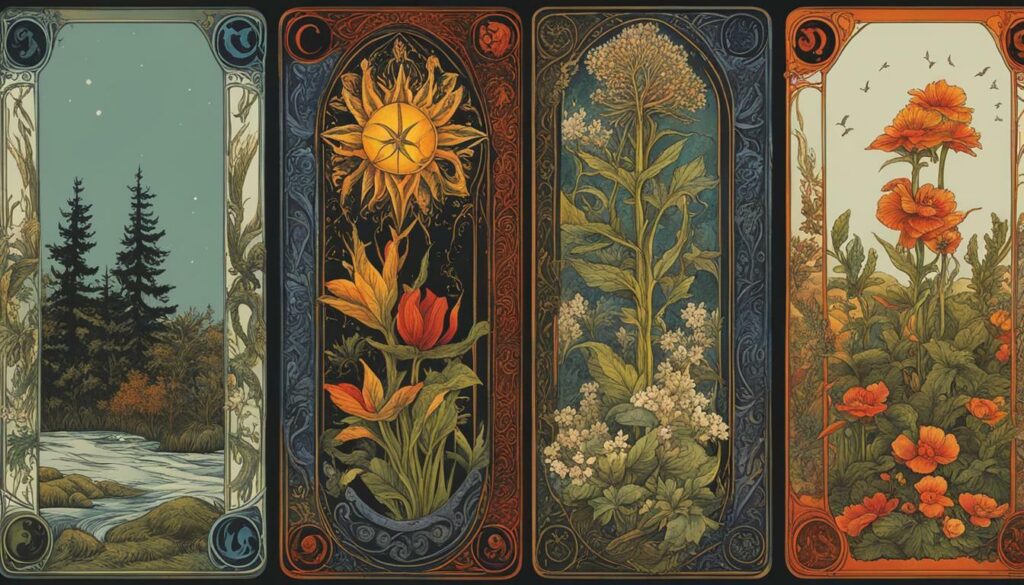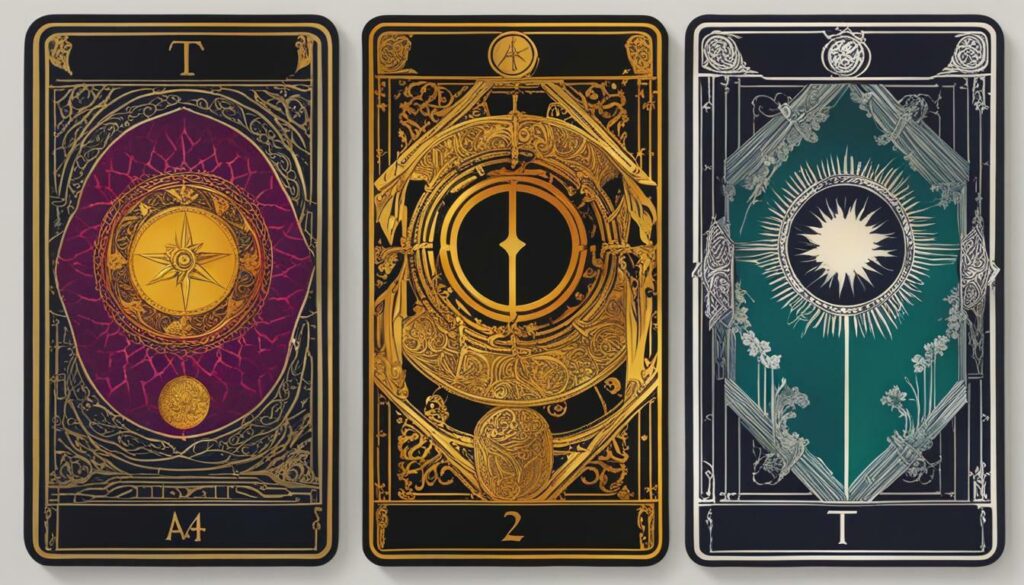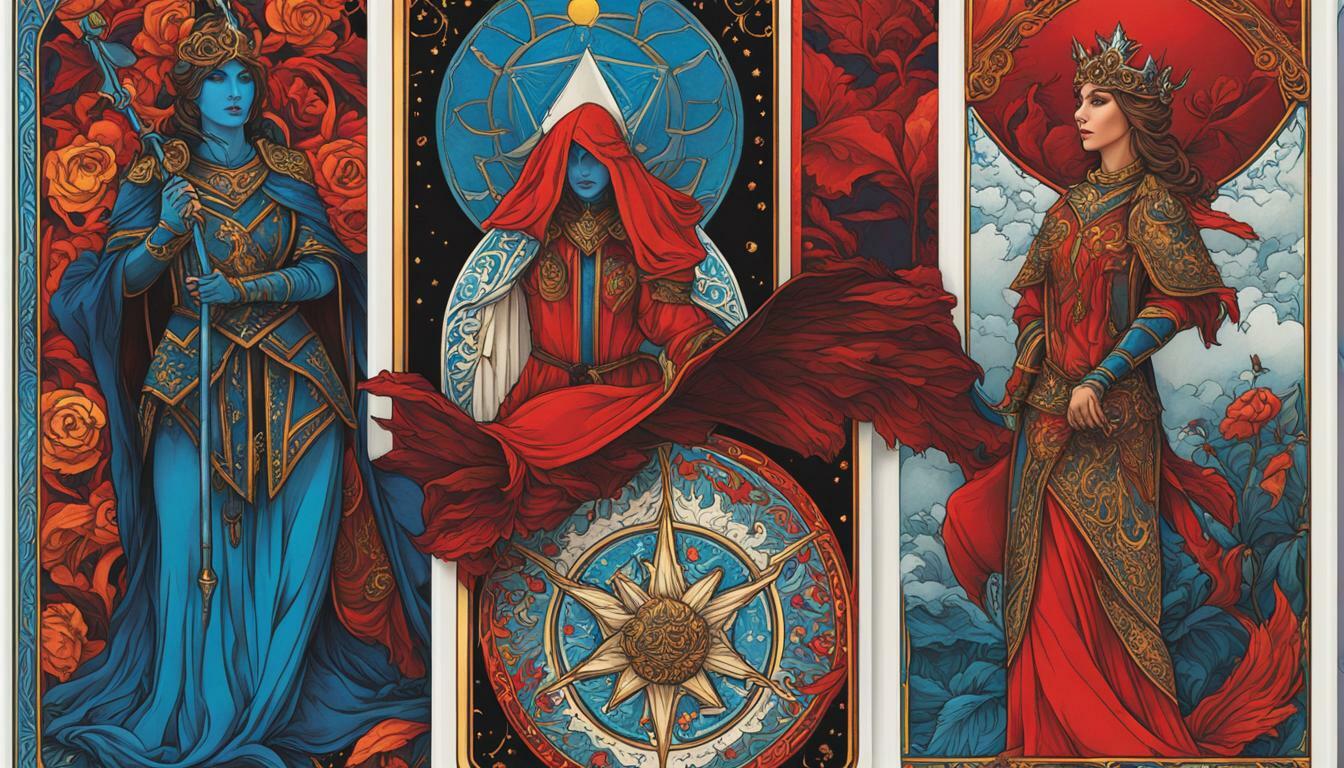As a professional tarot reader, we know that reversed cards in tarot provide a unique and complex layer of interpretation. They often reveal hidden energies and can offer insight into areas of life that need attention. One powerful tool that we can use to enhance our understanding of reversed cards is color symbolism.
In tarot readings, colors carry their own meanings and can convey different emotions and energies. By understanding the symbolism of colors and their significance in tarot cards, we can use color associations to interpret reversed cards and gain deeper insights into the energies at play.
Key Takeaways:
- Understanding the symbolism of colors in tarot readings can deepen your interpretation of reversed cards.
- Colors convey different energies and emotions and can assist in unlocking hidden meanings within tarot cards.
- By using color associations and paying attention to color patterns, you can enhance your tarot reading skills and gain deeper insights into complex readings.
Understanding the Symbolism of Reversed Tarot Cards
Interpreting reversed tarot cards can be challenging, but understanding the symbolism behind them can help you gain deeper insights into your readings. Reversed cards can indicate blockages or obstacles in a particular area of your life, or suggest that a situation is at a standstill.
It’s important to note that reversed cards do not always have negative connotations. In fact, they can often indicate a need for introspection or a shift in perspective. By understanding the nuances of reversed cards, you can unlock hidden meanings and gain a deeper understanding of the energies at play in your life.
The symbolism of reversed tarot cards can vary depending on the deck and the individual cards, but there are some common interpretations to keep in mind. In general, reversed cards can suggest a lack of harmony or balance in the area that the card represents. They can also indicate a need for caution or a warning of potential pitfalls.
For example, the reversed Tower card in the Rider-Waite deck can signify a sudden upheaval or crisis. However, it can also indicate a need for a shake-up or a breakthrough in a stagnant situation. The reversed Empress card can suggest a lack of nurturing or overindulgence, while the reversed Chariot card can indicate a loss of direction or control.
When interpreting reversed cards, it’s important to consider the context of the surrounding cards and the overall spread. A reversed card may have a different meaning depending on its position within the spread and the cards that surround it.

By understanding the symbolism of reversed tarot cards, you can gain a deeper understanding of the energies at play in your life. With practice and intuition, you can use the symbolism of reversed cards to unlock hidden meanings and gain new insights into your tarot readings.
Exploring the link between color and tarot card meanings
Understanding the significance of color in tarot cards is crucial to interpreting reversed tarot cards. Each color carries its own symbolism, and by understanding the color associations, you can unlock deeper layers of meaning in tarot readings.
When reading reversed tarot cards, it’s important to pay attention to the colors present in the card. Is the color darker or lighter than usual? Are there any new colors present? These color changes can offer valuable insights into the energies and emotions at play.
For example, if the reversed card typically signifies a negative energy, such as the Tower card, but it has a lot of bright yellow in it, this could indicate that the negative energy is necessary for growth and transformation, and that hope and optimism are still present despite the challenges ahead.
It’s also important to consider the overall color scheme of a tarot reading. Are there any patterns or themes that emerge? For example, if a reading has a lot of blue tones, this could indicate a focus on emotions and communication.

Furthermore, understanding the significance of color in tarot decks can help you interpret reversed cards more accurately. Different tarot decks may have slightly different associations with colors, so it’s essential to familiarize yourself with the specific symbolism of the deck you are using.
To better understand how to read reversed tarot cards with color symbolism, let’s explore some practical tips in the next section.
Using color to enhance tarot readings
Interpreting reversed tarot cards can be challenging, but incorporating color into your readings can help you gain deeper insights into the energies at play. Here are some tips for using color to enhance your tarot readings, especially when interpreting reversed cards:
- Focus on color patterns: When multiple cards in a spread share a similar color, it can signify a strong theme or energy present in the reading. Pay attention to how these colors interact with the reversed cards and what messages they might be conveying.
- Use color associations: Each color has its own symbolic associations and emotional impacts. Consider the traditional meanings of colors in tarot readings and how they can influence the interpretation of reversed cards. For example, red can symbolize passion, energy, and action, while blue can signify calmness, communication, and introspection.
- Pay attention to emotional impacts: Colors can evoke strong emotional responses, so take note of your own emotions when reading reversed cards. Consider how the colors in the card might be affecting the emotions of the people or situations represented in the reading.

By incorporating these techniques into your readings, you can deepen your understanding of reversed cards and gain a more holistic approach to reading tarot cards. Remember that interpretation is not always black and white, so trust your intuition and allow the colors to guide you in your tarot journey.
Interpreting reversed tarot cards in different spreads
When it comes to interpreting reversed tarot cards, the position of the card within a spread can greatly influence its meaning. Here are some tarot card spreads that focus on reversed cards:
Three-card reversed spread
This spread consists of three cards, with the first two representing the problem and its potential solution, while the third card sheds light on what needs to be learned from the situation. When interpreting reversed cards in this spread, pay attention to the color patterns and associations to understand the underlying blockages that need to be addressed.
Celtic cross reversed spread
The Celtic cross spread is one of the most common tarot spreads, and its reversed variant adds an extra layer of complexity. When reading reversed cards in this spread, consider the position of the card and its relation to the other cards. Using color symbolism can help you identify the root cause of the problem and suggest possible solutions.
Other spreads that are suitable for interpreting reversed tarot cards include the past-present-future spread, the five-card spread, and the yes/no spread.
Remember that the interpretation of reversed cards is not set in stone and can vary depending on the reader’s intuition and the context of the reading. Trust your instincts and let the colors guide you in uncovering the hidden messages of the cards.

Symbolism of colors in tarot decks
Colors play a significant role in tarot symbolism, and each color carries its own meaning and energy. In tarot decks, the use of colors is intentional and serves as an important tool for interpretation. By understanding the symbolism of colors in tarot decks, one can gain deeper insights into the meaning of reversed cards.
In many tarot decks, the colors used in the design of cards are intended to correspond with the elements of Earth, Air, Fire, and Water. For example, Pentacles in the Rider-Waite-Smith deck are associated with Earth and are typically depicted in shades of green, while Swords are associated with Air and often depicted in shades of blue or grey.
However, not all tarot decks follow the same color associations. Some decks, such as the Thoth Tarot, use a more complex system that incorporates astrological correspondences. In this deck, each color is assigned to a specific planet and element, creating a more intricate web of associations.
It is important to note that the symbolism of colors in tarot can vary depending on the deck and individual interpretation. Therefore, it is crucial to have a clear understanding of the specific deck being used and the intentions of the creator.

When interpreting reversed cards in tarot readings, paying attention to the colors used in the card design can provide valuable insight into the meaning of the card. For example, a reversed Four of Cups in the Rider-Waite-Smith deck is typically depicted in shades of blue, suggesting emotional stagnation and a lack of engagement with the world around them.
Similarly, a reversed Three of Swords in the same deck features more muted tones of grey and black, emphasizing the pain and despair associated with this card.
In conclusion, understanding the symbolism of colors in tarot decks is an essential aspect of tarot interpretation, especially when it comes to reversed cards. By paying attention to the colors used in card design, one can gain a deeper understanding of the energies and emotions at play in a tarot reading.
Conclusion
In conclusion, we have explored the significance of color in tarot readings and how it can be used to interpret reversed cards. By understanding the symbolism of colors and their meanings in tarot, you can deepen your understanding of reversed cards and enhance your tarot reading skills.
We have also discussed the nuances of reversed tarot cards and the different interpretations that can affect the overall meaning of a tarot reading. Understanding the symbolism of reversed cards is crucial in tarot interpretation, as they often reveal hidden or blocked energies.
By exploring the connection between color and tarot card meanings, we can unlock deeper layers of meaning in reversed cards and enrich our tarot readings. Each color carries its own symbolism and can convey different energies and emotions.
Practical tips were provided on how to use color to enhance your tarot readings, especially when interpreting reversed cards. Techniques such as focusing on color patterns, using color associations, and paying attention to the emotional impacts of different colors can help develop a more holistic approach to reading tarot cards.
Specific tarot card spreads for reversed cards were discussed, providing insights into how to interpret reversed cards in different positions and how color can assist in their interpretation.
Symbolism of Colors in Tarot Decks
Finally, we delved deeper into the symbolism of colors in tarot decks, including how different decks incorporate color symbolism and how this can influence the interpretation of reversed cards. By understanding the unique symbolism of colors in various tarot decks, we can expand our tarot reading repertoire.
In conclusion, the use of color in interpreting reversed cards in tarot can greatly enhance the depth and accuracy of our readings. By understanding the symbolism of colors in tarot decks and using color associations to interpret reversed cards, we can uncover hidden meanings and gain deeper insights into the energies at play. Remember to trust your intuition and allow the colors to guide you in your tarot journey.
FAQ
Q: How can I use color to interpret reversed cards in tarot?
A: Color can be a powerful tool in interpreting reversed tarot cards. By paying attention to the colors present in the card and understanding their symbolic meanings, you can gain insights into the reversed energy and its implications in the reading.
Q: What is the significance of color in tarot cards?
A: Colors in tarot cards carry their own symbolism and can convey different energies and emotions. They can provide additional layers of meaning to the card’s interpretation, including when it is reversed.
Q: How do reversed cards affect the overall meaning of a tarot reading?
A: Reversed cards often reveal hidden or blocked energies. They can indicate challenges, obstacles, or a need for inner reflection. Understanding their interpretations can help provide a more accurate and holistic reading.
Q: What techniques can I use to enhance my tarot readings with color?
A: There are various techniques you can use, such as focusing on color patterns in the cards, using color associations to deepen your understanding, and considering the emotional impacts of different colors. These strategies can add depth and nuance to your tarot readings, particularly when interpreting reversed cards.
Q: Are there specific tarot spreads that focus on reversed cards?
A: Yes, there are tarot spreads specifically designed to explore reversed cards. These spreads allow you to interpret the reversed card’s position within the spread, providing insights into the challenges or opportunities presented by the reversed energy.
Q: How can the symbolism of colors in tarot decks influence the interpretation of reversed cards?
A: Different tarot decks may incorporate their own color symbolism, which can influence the interpretation of reversed cards. It is important to familiarize yourself with the symbolism of colors in the specific deck you are using to fully understand the messages conveyed by reversed cards.

